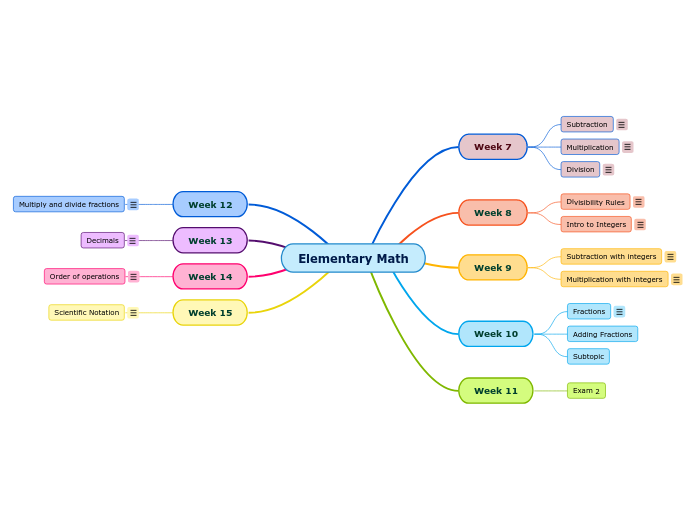
Subtraction
Phrase subtraction as "_ take away_"Expanded Form425-204= (400+20+5)-(200+0+4)=200+20+1=221helps reinforce place valueEqual Addendsadding the same amount of units to the top number and bottom number of the problem to make one of the numbers end with a zero and then subtract.
Multiplication
About multiplicationmultiplication is repeated addingshould be phrased as "_ groups of _" Timed Tests are bad. They create unneeded stress and hurt a child's self-esteem. The order to teach Times Tables in is:Group one: 1s, 2s, 5s, 10sGroup two: 9s, Doubles, 3sGroup three: 4s, 6s, 7s, 8s. NO TRICKS!!! I repeat NO TRICKStricks hurt more than they helpExpanded Formexpand place values of each number in the problem and then multiply up then acrossjust like expanded form for subtraction and additionLatticedraw the lattice box with diagonal lines and write one # on the top and the second number on the right then multiply across working right to left.Left to Rightmultiply starting with the left side similar to expanded up and across then addjust like expanded form but without expanding the place values
Division
Long DivisionThe worst methodstudents have a hard time remembering where the numbers should go when setting upthey also have a hard time understanding what the remainder means and where to get the numbers Repeated SubtractionGood for students at any levelstudents can use the times tables that they are more comfortable with like 5's and 10'sthey still have to know how to set it up and the remainder is still trickyUpwards Divisionwrite the problem like a fractionfind how many times the denominator can go into the numerator; write it on the other side of the equal sign. Then multiply it then subtract that number from first digit then repeat.This method produces the remainder
Divisibility Rules
Divisibility RulesAnything is divisible by 1Even numbers are divisible by 2. The last digit has to be 0,2,4,6, or 8.If the sum of the digits is divisible by 3If the last two digits are divisible by 4If the number ends in 5 or zeroIf the 2 and 3 work then 6 works. The number has to be divisible by both 2 and 3. Rules don't apply to 7If the last three digits are divisible by 8If the sum of the digits equals 9If the last digit of the number is a zero.
Intro to Integers
IntegersWhen building integers, red is always negativeWhen pairing integers up positives are always on top and negatives are always on bottom.Zero bank: creating pairs of negatives and positives to cancel each other out so that you have enough integers to work withAddition: Building/showing: 5+2 is 5 positives plus 2 positives-5 +2 is 5 negatives plus 2 positives or 5 reds and 2 yellows
Subtraction with integers
Building Subtraction with integers:Start with zero bank if needed -7-2= "7 negatives takes away 2 positives"
Multiplication with integers
Multiplication with integers7(3) should be said like "take away 7 groups of 3 positives"need a zero bank!
Fractions
Fractions Numerator tells number of pieces of shapes Denominator tells how big the pieces are. Has an inverse relationship. Bigger the number, the smaller the piecesButterfly method is bad. Just a short cut to the answer. creates no real understanding of fractions
Adding Fractions
Subtopic
Exam 2
Multiply and divide fractions
Multiplying Fractions: Factor numerator to denominator and look for for Funky 1 to simplify before multiplying, then multiply across. If done right there will be no need to simplify except for mixed numbers. Mixed number multiplied by mixed number: Do the backwards "C" to multiply denominator by whole number then add to numerator. Then just multiply like normal fractions and finding the funky ones. Dividing fraction by fraction: use KEEP, CHANGE, FLIP (KCF) (multiply by the reciprocal), then treat the problem like a normal fraction multiplication problem with funky ones
Decimals
Decimals:For showing decimals you do basically the same thing as showing fractions except the boxes will always be split into 10 or 100.Solving: Line up whole numbers; add zeros if needed.When doing any decimal math problem Estimate First
Order of operations
Order of OperationsGroupsExponentsD/M from L->RS/A from L->R*Groups are separated by addition/subtraction signs.
Scientific Notation
Scientific Notation: 3 parts of a sci. note. problem: decimal needs to be between |1-10|, multiplying by 10, and A positive or negative exponent Negative exponents =fractions and are less than 1. Positive exponents =more than 1.